



Fashion historians and observers have always found a direct relation between fashion and the economy. They have gone on to make certain trends as economic indicators—the lipstick index, the rise and fall of hemlines, and most recently, the sale of men’s underwear if Warren Buffet is to be believed. Fashion as a reaction or reflection of the times.
What then do we make of all the gold embellishments, the flapper dresses, and the exuberant prints seen on the Milan spring 2012 runways? Are we headed for better days? Will the global economy be on the upswing when these clothes make it to the stores in February? Or do the glitz and swingy vibes serve merely as diversions from all the bad news? An escapist’s route?
You would thing that we’re in for happier times ahead at the sight of all the black and gold flapper dresses at Gucci or the gold beaded jackets and evening gowns at Roberto Cavalli. There was a lot of shine and sparkle, especially at Gucci where the inspirations were the gleaming skyscrapers of New York, particularly the Chrysler Building.
There was also a cacophony of prints in trippy colors in Milan. Dolce & Gabbana’s collection was heavy with vegetable prints— flirty skirts with red chilies, swimsuits covered with tomatoes, and dresses drowning in aubergines. Does the use of produce as a motif signify a bountiful harvest for global economic markets come spring? Here’s to hoping it would be for Dolce & Gabbana since they are shutting down their D&G line after this season.
Milan, a fashion powerhouse city that keeps design houses living in a time machine two seasons ahead of every lay person is in full swing with a mind-boggling 70 catwalk shows and 50 showroom exhibitions during their famed Milan Fashion Week.
The premier fashion event is not only a place to glean the best of fashion, stars and glam afterparties; it’s also a place to make big announcements, such as the one that Domenico and Stefano made regarding a change to the D&G label:
“…From the upcoming seasons, D&G will become part of Dolce & Gabbana, giving even more strength and energy to our collections…”
Although this move may have been economically-motivated, it seems that most agree: while there are only a few companies with expansion plans (like Gucci and Vuitton), high-fashion is not strongly impacted by economic downturns. High fashion is always coveted. Especially now, considering there are huge, emerging markets.
Ferragamo will launch its first jewellery collection Wednesday, offering a beautiful, dependable investment: gold.
Some top brands are widening their entry-level offers in order to remain popular among the price-sensitive, such as Missoni opening a line through the American department store, Target; however many higher-end design houses are simply not making any changes, preferring to work on a small-scale with deep-pocket fans.
In fact, Italian brands are an economic engine, expecting to generate almost 63 billion euros ($87 billion) this year, according to the Chamber of Fashion.
So for anyone flying into Milan; life shines like gold.


